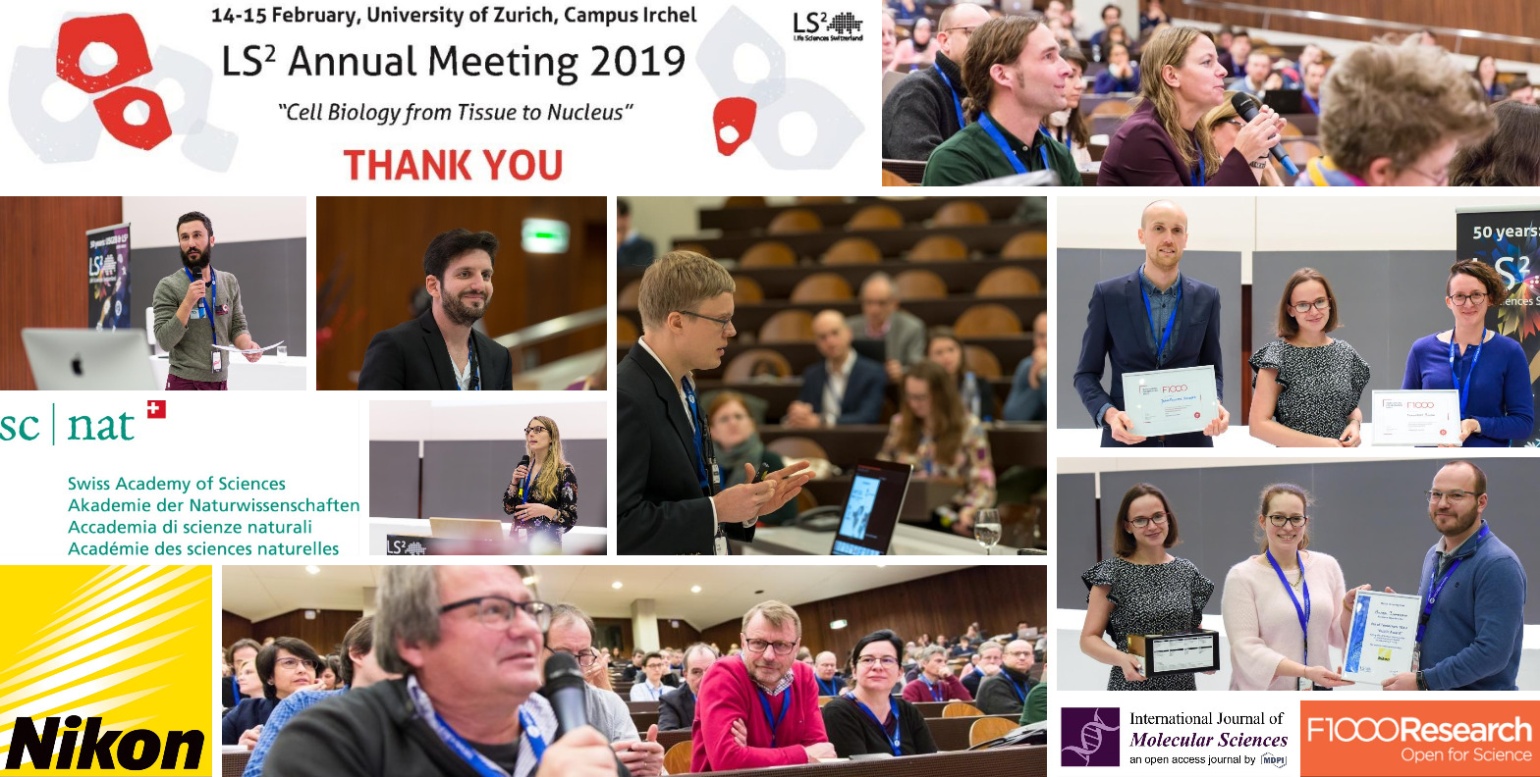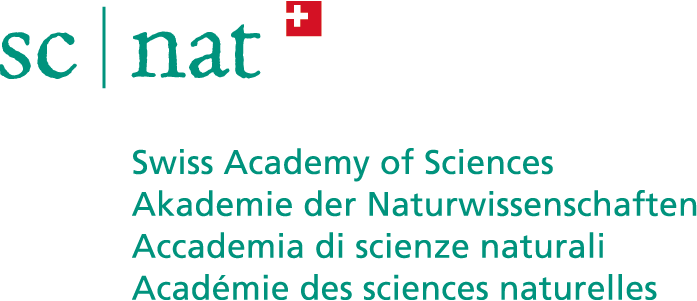Proudly presenting the winners!
Jury prize: Francesca Ronchi (University of Bern) & Jean-Philippe Krieger (Gothenburg University). Prize sponsored by F1000Research.
Public prize: Michael Zimmermann (Yale University), sponsored by Nikon.
(Additional support by SCNAT and the International Journal of Molecular Sciences, an open-access journal by MDPI).

Announcing our finalists of the 2019 edition of "PIs of Tomorrow"!
Dear all
We received 53 eligible (inter)national applications after the deadline. A big thanks goes to all of you for your efforts and to the evaluation committee for their tough work to select the best applications.
We're proud to present our finalists below
Please note that all applicants are kindly invited to come to the LS2 Annual Meeting 2019 without registration fees. To make use of this offer, please register normally here and send in addition a quick mail to info@ls2.ch, so we'll cancel your automatically generated bill.
We're very much looking forward to the session!
With best wishes
The PIs of Tomorrow committee
Francesca Ronchi, University of Bern
Host-microbial interaction in brain homeostasis and inflammation
During my research experiences, I acquired excellent knowledge into both basic and applied immunology. I performed my PhD investigating on the first phases of multiple sclerosis (MS) pathogenesis in animal models, with particular emphasis on the role of innate inflammasome mechanisms and T cells.
As Postdoctoral fellow I have investigated the role of inflammasome in regulating the host-microbiota interaction in the gut under homeostatic and healthy conditions. I have also showed that molecular mimicry is a novel mechanism by which the gut microbiota can regulate normal immune homeostasis.
My future plans are aimed to better understand how the gut microbiota shapes the immune homeostasis of the brain and how alterations in the gut microbiota composition might modulate susceptibility to MS. I aim to decipher the molecular mechanism of how the diet and the microbiota can modulate the induction and perpetuation of immune responses in mouse model for MS. Specifically, I want to investigate whether and how intestinal commensal bacteria and diets can shape the phenotype and function of pathogenic immune response in mice under different hygiene conditions. To achieve this goal, I will combine my extensive knowledge in the mouse model of MS, T cell biology, and microbiota. In brief, I will use the spontaneous animal model for MS, which reflects the human Western variant of MS, and will combine significant technological advances in the areas of next generation sequencing techniques and gnotobiology to identify central nervous system and immunological molecular pathways induced by the intestinal bacteria. My approach will push the technological and scientific knowledge of this specific topic beyond the current state-of-the-art. Overall my projects will provide the explanations for the impact of diet and microbiota on the susceptibility to autoimmune neurological diseases and will open new horizons for my future translational research as well.
Thomas C. T. Michaels, Harvard University, Cambridge, MA, USA
Bridging time and length scales in biomolecular self-assembly
My research focuses on developing quantitative theoretical approaches to understand biological self-assembly processes across length- and timescales, and connect microscopic mechanisms with macroscopic observations of such phenomena.
Self-assembly is key for biological function, but is also at the heart of pathologies of many types and finds widespread nanotechnological applications. However, to exploit self-assembly for nanotechnology or curtail it for medical purposes it is necessary to quantify its underlying physical principles, which remains elusive in most cases. Laying a basis for such a programme has been a major objective of my past research. A first step has been to develop a unified kinetic theory of filamentous protein aggregation [1], a process associated with Alzheimer’s disease. I then applied this work to study the mechanisms of inhibition of pathological protein aggregation [2] and develop explicit rational drug discovery strategies [3]. Increasing in complexity, I have investigated strategies to control protein aggregation in time [4] and space [5], e.g. using liquid cellular compartments. I also did extensive work on the mechanics and geometry of filamentous aggregates to investigate force generation [6], the range of possible fibril shapes [7], or to study functional processes, such as microtubules’ dynamic instability [8].
Building on my previous research, in the future I aim to understand:
1) the origin and role of fluctuations in self-assembly, as a step towards modeling self-assembly processes in the cellular environment;
2) the feedback between geometry, mechanics and kinetics in self-assembly, to understand key aspects of functional assembly and help designing novel programmable materials;
3) the non-equilibrium principles driving self-assembly reactions and the manner by which they constrain the dynamics and accuracy of these phenomena.
Through this research programme, I intend to probe the fundamental driving forces and general physical/energetic constraints that direct biological self-assembly towards the formation of one structure or another.
References:
[1] T.C.T. Michaels, et al. Phys. Rev. Lett. 116, 038101 (2016); [2] P. Arosio, T.C.T. Michaels, et al. Nature Communications 7, 10948 (2016); [3] S. Chia*, J. Habchi*, T.C.T. Michaels*, et al. PNAS 115, 10245 (2018). (*equal contribution); [4] T.C.T. Michaels, C.A. Weber, L. Mahadevan, “Optimal strategies to inhibit protein aggregation”, biorXiv:456590, under review Nature Communications (2018); [5] C.A. Weber*, T.C.T. Michaels*, L. Mahadevan, arXiv:1809.03472, under review eLife (2018). (*equal contribution); [6] A. Levin*, T.C.T. Michaels*, et al. Nature Physics 12, 926 (2016). (*equal contribution); [7] T.C.T. Michaels, L. Mahadevan, “Mechanical basis for the morphology of fibrillar aggregates”, under review Phys. Rev. Lett. (2018); [8] T.C.T. Michaels, et al. “Mechanics and kinetics of microtubule dynamic instability”, submitted PNAS (2018).
Michael Zimmermann, Yale University, West Haven, CT, USA
Harnessing microbial xenobiotic metabolism for mechanistic understanding of host-microbiota interactions
The gut microbiota plays an essential role in human health and numerous studies link changes in microbiota composition to various diseases and altered drug response. The underlying mechanism is often thought to be tightly linked to altered metabolic activity of the microbiota upon its compositional changes. However, the current view on microbiota and its metabolic interplay with the host and the environment often remains descriptive relying on correlative analyses between observations of interest and microbial community composition.
My goal is to elucidate the metabolic interplay between host and intestinal microbes at the molecular level. During my postdoctoral time, my research focused on the microbial capacity to chemically modify medical drugs and on how microbiota composition quantitatively affects hosts' drug response, efficacy, and toxicity. I have developed experimental and computational approaches to identify microbiome-encoded features that impact small molecule metabolism at scales from communities to species and enzymes. My future lab will continue to investigate the pharmacological impact of microbial drug metabolism and expand the established approaches to additional xenobiotics, food components, and endogenous compounds to dissect physiological host-microbiota interactions. We will combine systems biology approaches, such as metabolomics, genomics, and mathematical modeling with biochemistry, bacterial genetics, and animal models to identify community-defining bacterial gene products and to study microbial metabolism in vitro and in vivo to decipher the chemical language between members of the microbiota and between microbes and their host.
My research will establish causal links between inter-individual microbiome variation and altered host physiology, such as disease states or interpersonal differences in drug metabolism. These findings could have direct and rapidly translatable impact on medical therapy. Furthermore, in contrast to polymorphisms in our human genomes, gut microbial community composition can be rapidly modified, potentially providing novel intervention strategies.
Jean-Philippe Krieger, Gothenburg University, Sweden
The Voice from Within: Leveraging the Gut-Brain Axis to Reduce Symptoms in Patients with Schizophrenia.
Schizophrenia is a debilitating psychiatric disorder in which patients lose touch with reality and commonly experience hallucinations, anxiety or depressive symptoms. Current treatments primarily aim at correcting central neurotransmitter imbalances with antipsychotics, but long-term efficacy and neurological disorders are major pitfalls.
Surprisingly, gastrointestinal disorders and autonomic nervous system imbalance are frequent comorbidities of schizophrenia, suggesting that impaired somatic signaling via the peripheral nervous system may be involved in the pathophysiology of schizophrenia. I therefore propose to approach schizophrenia from a genuinely new angle, by leveraging the modulatory role of the gut-brain axis on behavior and brain neurochemistry.
Recently, I found that interrupting the main neuronal route of ascending communication between the gut and the brain in rats (i.e. vagal afferents) triggers behavioral deficits and brain transcriptional changes relevant to schizophrenia. My current goal is to unravel the gut-brain neuronal circuitry underlying these effects and target this vagal circuitry for therapy.
First, to confirm the therapeutic potential of the vagal pathway in schizophrenia, I will test whether optogenetic stimulation of vagal afferents is sufficient to improve schizophrenic-like behaviors (reduced prepulse and latent inhibition, anhedonia) in mice models of the disease (social isolation and prenatal immune activation). Second, to identify the underlying neuronal circuitry, I will map brain areas synaptically connected to vagal afferents using anterograde multisynaptic tracing. Their functional necessity to the beneficial effect of vagal stimulation will be further tested using caspase-induced lesions. Third, a logical step towards therapy will be a proof-of-principle study where behavioral symptoms of treatment-resistant schizophrenic patients will be monitored after implantation of a vagus nerve electrical stimulation device.
In short, this project will tackle schizophrenia from a novel and innovative angle and has the potential to provide a new therapeutic option to the 20 million schizophrenic patients worldwide.
Juho Pokki, Stanford University, Stanford, CA, USA
Biomechanics of metastasic cancer development: in vitro and in vivo technologies for diagnosis and treatments
My expertise is in biomechanics, medical engineering, and microtechnologies. I have applied this expertise in developing systems that interact with biological structures to provide guidance for surgeries1-2 , to develop diagnostics3 , and to facilitate drug delivery4-5. While earning my PhD at ETH Zurich in Prof. Nelson's group, I contributed to the field of medical micro/nanorobotics with over 10 journal publications. Currently, I am a postdoctoral fellow at Stanford University, developing systems for micromechanical characterization of cancer tissue (in Prof. Chaudhuri's group) and advancing live-cell rheometry (in Prof. Fuller's group). I propose to combine biomechanical research, engineering and biology to develop technologies that quantify how the biomechanical state of cells and tissues changes from healthy to diseased.
Although biomechanical alterations change cell/tissue behavior in multiple diseases, mechanical properties mostly remain unused in diagnosis and treatments. Metastatic cancer, causing >90% of cancer deaths, is regulated by biomechanical processes within cell/tissue microenvironment6 . Because few tools provide mechanical information on the microenvironment, I will focus on quantification of metastatic cancer's biomechanical development at the microscale. Studies of cancer biomechanics report almost exclusively elasticity/stiffness, however, cancer cells7 and tissues8 exhibit time- and rate-dependent viscoelasticity. Therefore, I will investigate viscoelasticity related to cancer disease state and metastatic transformation, and develop technologies to discover the relevant biologydriven mechanical patterns in disease states. I will develop in vitro microtechnologies for diagnosis in personalized medicine, using biopsies from patients. Further, I will advance non-invasive in vivo biomechanical imaging for such diagnosis. After detecting metastatic potential, the in vitro and in vivo technologies could screen for drug efficacy. Additionally, the in vivo technology could provide more efficient, safer procedures via pre/intraoperative planning, and minimally-invasive surgeries that limit not only manipulations but also forces exerted on tissues. This research has the potential to impact clinical science and ultimately public health.
REFERENCES
[1] J Pokki, J Parmar, O Ergeneman, H Torun, M Guerrero, E Pellicer, J Sort, S Pané, and BJ Nelson. Mobilityenhancing coatings for vitreoretinal surgical devices: hydrophilic and enzymatic coatings investigated by microrheology. ACS Appl Mater Interfaces 7 (2015): 22018-22028.
[2] J Pokki, O Ergeneman, S Sevim, V Enzmann, H Torun, and BJ Nelson. Measuring localized viscoelasticity of the vitreous body using intraocular microprobes. Biomed Microdevices 17 (2015): 84-92.
[3] O Ergeneman, G Chatzipirpiridis, J Pokki, S Pané, M Marin-Suárez, GA Sotiriou, S Medina-Rodriguez, JF Fernández Sánchez, A Fernández-Gutiérrez, S Pané, and BJ Nelson. In vitro oxygen sensing using intraocular microrobots. IEEE T Bio-Med Eng 59 (2012): 3104- 3109.
[4] G Chatzipirpiridis, O Ergeneman, J Pokki, F Ullrich, S Fusco, JA Ortega, KM Sivaraman, BJ Nelson, and S Pané. Electroforming of implantable tubular magnetic microrobots for wireless ophthalmologic applications. Adv Healthc Mater 4 (2015): 209-214.
[5] J Pokki, O Ergeneman, KM Sivaraman, B Özkale, MA Zeeshan, T Lühmann, BJ Nelson, and S Pané. Electroplated porous polypyrrole nanostructures patterned by colloidal lithography for drug-delivery applications. Nanoscale 4 (2012): 3083-3088.
[6] CT Mierke. The fundamental role of mechanical properties in the progression of cancer disease and inflammation. Rep Prog Phys 77 (2014): 076602.
[7] N Bonakdar, R Gerum, M Kuhn, M Spörrer, A Lippert, W Schneider, KE Aifantis, and B Fabry. Mechanical plasticity of cells. Nat Mater 15 (2016): 1090.
[8] B Babaei, AJ Velasquez-Mao, KM Pryse, WB McConnaughey, EL Elson, and GM Genin. Energy dissipation in quasi-linear viscoelastic tissues, cells, and extracellular matrix. J Mech Behav Biomed Mater 84 (2018): 198-207.
Jury Members of the session
Leonie Ringrose (Humboldt University Berlin)
Christian Heinis (EPF Lausanne)
Federica Sallusto (ETH Zurich)
Martin Müller (University of Zurich)
Michele de Palma (EPF Lausanne)
Suliana Manley (EPF Lausanne)
Matthias Peter (ETH Zurich)
Nicole Joller (University of Zurich)
Instructions for your application (closed now)
Dear postdocs and advanced researchers,
We are very pleased to announce the special session "PIs of Tomorrow - The Future of Swiss Research" that will be held next year at the upcoming Life Sciences Switzerland (LS2) Annual Meeting (February 14-15 2019, University of Zurich). This session offers an opportunity to postdocs and senior researchers interested in pursuing an academic career to present a talk similar in format to a professorship application interview. A knowledgeable jury panel of professors will evaluate the presentations and provide feedback in a one-on-one session afterward. In 2019, the session will be for the first time a plenary session!
Please refer to the official PDF document with instructions below to enter the competition to be one of the five speakers selected from all applications.
Applications must be received by November 1, 2018.
We aim to promote equal opportunities for women and men and encourage female scientists to apply.
If you are selected, your travel and accommodation fees will be paid by the LS2 organization.
Please feel free to spread the word to other potential candidates!
We are looking forward to your application and hope to welcome you in Zurich!
Best wishes,
On behalf of the LS2 organizing committee,
Nino Nikolovski, Aleksandra Konovalova, Elisa Araldi & Emanuela Milani
Chairs of the session, ETHZ AMB
www.amb.ethz.ch
and
Carolin von Schoultz
Organizer of the conference, Scientific Officer LS2
www.ls2.ch
www.annual-meeting.ls2.ch




